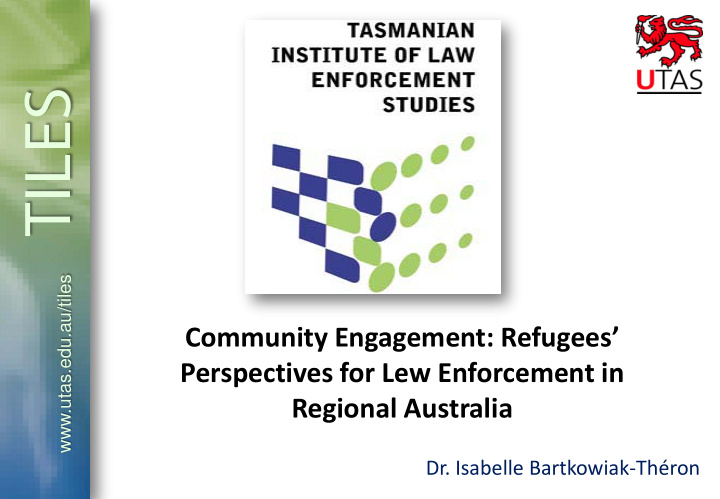



TILES www.utas.edu.au/tiles Community Engagement: Refugees’ Perspectives for Lew Enforcement in Regional Australia Dr. Isabelle Bartkowiak-Théron
BACKGROUND • UTAS TILES • Emphasis on Excellence and Distinctiveness (qualities that in turn encourage relationships that facilitate Growth and Engagement) • Leader and facilitator of endeavours that connect with the wider community • Encourages appplied projects that link academics www.utas.edu.au/tiles with practitioners and the community • VC’s Community Engagement Grant • TILES “is committed to excellence in law enforcement research. Collaborative research that links academics with practitioners is a hallmark of that research”
PROJECT DESIGN • TILES Report ‘A Conversation on Trust’, 2009 TILES • Report allow refugees a voice on relationships between Police and Refugees • Problem with report: ‘a framework-only report’ www.utas.edu.au/tiles • Need to design tools to • Further build bridges between police and refugees
The situation between refugees & police • Not easy (and not police only) TILES • Relationship of distrust, fear and avoidance • Triggers a number of problems • Under-reporting • Absence of collaboration • No knowledge of each others’ business & www.utas.edu.au/tiles tradition • No knowledge exchange between each other • Talking to the police = corrupt activity • Particularly problematic in big resettlement centres
SEIZING THE ENGAGEMENT OPPORTUNITY • Privileged situation in Albury TILES • Good networking with government ‘support agencies’ (NGOs, associations, etc) • Murray Valley Sanctuary Refugee Groups • Indication, despite concerns, of good work www.utas.edu.au/tiles by all support agencies AND • Indication of good relationships between refugees and police
THE PROJECT: ‘Bridging the Gap’ Documenting what works well TILES • in a medium-sized resettlement area • at a cross-border location • at a location where further refugee intakes are expected in the next few years • from the agencies’ perspectives www.utas.edu.au/tiles • from the refugees’ perspectives Purpose: constructing the tool box (random ‘MacGyverisms’ into effective instruments for future use in other location, by other partners) and the ‘how to manual’
PRELIMINARY RESULTS What are the things that are working well? • Teaching endeavours that are slow and incremental (Australian TILES induction ) • Anything that contextualises western governance paraphernalia • Anything that implies listening (and interest?) the refugees’ experience • Anything that builds on their resilience • Any collaborative endeavours www.utas.edu.au/tiles Anything fun (& that highlights their skills) • • Going through Elders • Abiding by the community hierarchy • Building on traditions of problem-solving • You’re wrong → ‘You’re right… and you’ll be more right if…’ For young people, strong teaching (didactic?) techniques •
PRELIMINARY RESULTS (cont’d): Why are those things working well? Strong collaboration of police officers to the bridging • exercise (AWCC) TILES • Participation to English classes (in uniform, in plain clothes) Police officers realising that ‘they themselves had no idea • traditional problem-solving process could be so similar to ‘our ways’, so sophisticated’ and so respected • Participation of refugees to police awareness training www.utas.edu.au/tiles “It’s nice to see the refugees excited to be the ones teaching, as opposed to being the ones receiving the information” It’s more about reassurance about what is gained as • opposed to what is lost (different understandings), what is shared as opposed to what is relinquished
PRELIMINARY ANALYSIS This CE engagement process has triggering TILES • An exercise in reflexivity among participants ‘ asking ‘how do you do this?’ ‘show us…’ • Erasing misconstrued differences: One of the benefits from asking that question ‘what do you www.utas.edu.au/tiles do’ and ‘you teach us’ was that they started to understand how and why (…) and to see that perhaps one of the ways that we offered to manage differences of opinion were mimicking what was happening in the community’ • It’s about people rather than systems
Recommend
More recommend